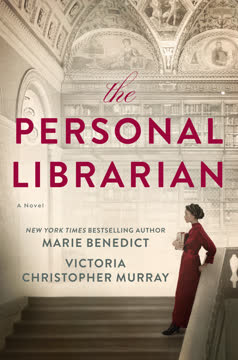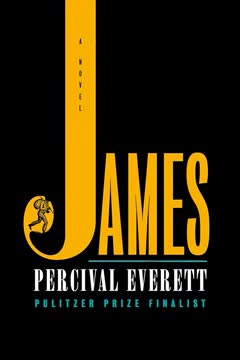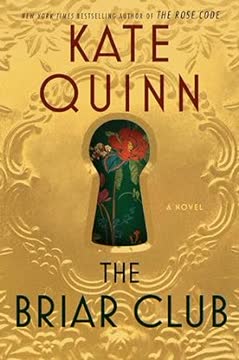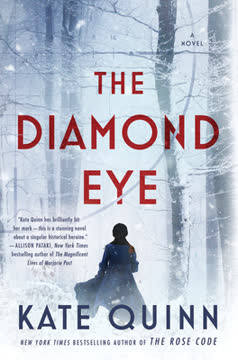Plot Summary
Two Names, One Secret
Belle da Costa Greene, born Belle Marion Greener, is a young woman of mixed-race heritage who passes as white in early 20th-century America. Her mother, Genevieve, insists on this deception to secure better opportunities for her children, while her father, Richard Greener, a prominent Black intellectual, is heartbroken by the choice. Belle's life is defined by the tension between her public persona as a sophisticated, educated white woman and her private reality as a Black woman forced to hide her true self. This secret is a constant source of anxiety, shaping her every interaction and decision, and is the foundation upon which her remarkable career and personal struggles are built.
The Morgan Library Beckons
Belle's talent attracts J.P. Morgan.
Working as a librarian at Princeton, Belle's expertise and passion for rare books catch the attention of Junius Morgan, nephew of the legendary financier J.P. Morgan. Through a fortuitous recommendation, Belle is invited to interview for the position of personal librarian to J.P. Morgan, who is assembling a world-class collection of manuscripts and art. The interview is a test of intellect, poise, and social navigation, as Belle must prove her worth while maintaining her carefully constructed identity. Her knowledge, ambition, and ability to charm Morgan secure her the coveted role, launching her into the rarefied world of New York's elite and setting the stage for her transformation into a cultural powerbroker.
Passing in Plain Sight
Navigating whiteness in high society.
As Belle assumes her new role, she is thrust into the upper echelons of New York society, where every gesture, word, and relationship is scrutinized. She must constantly monitor her appearance and behavior to avoid suspicion about her background, even as she excels in her work. Belle's family relies on her financial support, and her mother's relentless reminders about the dangers of exposure weigh heavily on her. The tension between her public and private selves intensifies, especially as she forms close relationships with colleagues and patrons, all while hiding the truth of her ancestry. The cost of passing is both psychological and emotional, isolating Belle even as she rises in prominence.
A Bargain with Destiny
Ambition and secrecy intertwine.
Belle's success at the Morgan Library is meteoric. She becomes indispensable to J.P. Morgan, advising him on acquisitions and representing him at auctions and social events. Her expertise and boldness earn her respect, but also envy and suspicion from others, including Morgan's daughter Anne. Belle's personal life is marked by sacrifice—she forgoes romantic relationships and personal fulfillment to protect her secret and support her family. The bargain she has struck—trading authenticity for opportunity—brings both triumph and loneliness, as she realizes that her achievements are always shadowed by the risk of discovery.
The Price of Whiteness
Family, love, and loss under the mask.
Belle's family remains her anchor and her greatest vulnerability. Her siblings benefit from her success, but the strain of maintaining their white identities creates distance and resentment. Belle's relationship with her mother is fraught, as Genevieve's pragmatism clashes with Belle's longing for connection and authenticity. The absence of her father, who cannot accept the family's choice to pass, haunts Belle. Romantic entanglements, particularly with the art historian Bernard Berenson, offer the promise of love but are ultimately doomed by secrecy, betrayal, and the impossibility of a future together. The emotional toll of passing becomes increasingly apparent as Belle faces heartbreak and isolation.
Building a Masterpiece
Transforming the Morgan Library into legend.
Belle's vision and tenacity transform the Morgan Library into one of the world's premier collections. She navigates the treacherous waters of art dealers, collectors, and socialites, outmaneuvering rivals and securing priceless treasures for the library. Her boldness at auctions, symbolized by her signature red scarf, becomes legendary. Belle's partnership with J.P. Morgan is both professional and deeply personal, marked by mutual respect, intellectual kinship, and unspoken longing. Together, they create a legacy that will outlast them both, even as Belle's own legacy remains precarious, built on a foundation of concealment.
Enemies and Allies
Rivalries, suspicion, and fragile alliances.
Belle's rise attracts both admirers and adversaries. She must contend with the jealousy of Anne Morgan, the scrutiny of society, and the machinations of art world rivals. Rumors about her background and her relationships swirl, threatening to expose her secret. Belle's ability to forge strategic alliances and deflect suspicion is tested repeatedly, especially as she navigates the complex dynamics of gender, race, and class. Her friendship with J.P. Morgan's family is fraught, and her professional reputation is constantly at risk. The precariousness of her position underscores the fragility of the world she has built.
The Burden of Family
Duty, guilt, and generational conflict.
Belle's sense of responsibility to her family is both a source of strength and a heavy burden. She supports her mother and siblings financially, ensuring their continued ability to pass as white. The family's dependence on her success creates tension and guilt, especially as Belle's own desires and needs are subsumed by duty. The generational conflict between her parents—her mother's pragmatism and her father's idealism—mirrors Belle's internal struggle. The death of her grandmother and the estrangement from her father deepen Belle's sense of loss and longing for belonging.
The Auction's Red Scarf
Defining moments of public triumph.
Belle's boldness at high-stakes auctions cements her reputation as a formidable force in the art world. Her dramatic victories, often signaled by her red scarf, are celebrated in the press and admired by peers. These public triumphs are bittersweet, as they come at the cost of personal sacrifice and the constant fear of exposure. Belle's success is a double-edged sword, bringing her acclaim and influence, but also increasing the scrutiny and risk that her secret will be uncovered. The tension between public adulation and private anxiety defines this period of her life.
Love and Betrayal
Romantic longing and devastating loss.
Belle's affair with Bernard Berenson is passionate and intellectually stimulating, but ultimately doomed by betrayal and the impossibility of a future together. The relationship is marked by moments of joy and intimacy, but also by abandonment, heartbreak, and the painful decision to end a pregnancy. Bernard's inability to fully commit and his own secrets mirror Belle's struggles, and their eventual estrangement is a profound loss for Belle. The experience leaves her wary of intimacy and reinforces the barriers that her secret imposes on her personal life.
The Cost of Ambition
Sacrifice, regret, and the limits of success.
As Belle's career reaches its zenith, the personal costs become increasingly apparent. The death of J.P. Morgan is a devastating blow, leaving Belle adrift and uncertain about her future. The transition to working with Jack Morgan brings new challenges, as she must fight to preserve the library's legacy and her own position. Belle's reflections on her choices—her decision to pass, her sacrifices for family, her lost loves—are tinged with regret and longing for a life that might have been. The limits of ambition are laid bare, as Belle confronts the reality that success cannot fully compensate for the loss of self.
The Library's Lady Directress
Legacy, recognition, and the weight of history.
Belle becomes the public face of the Morgan Library, celebrated as its "lady directress" and a pioneering woman in a male-dominated field. Her achievements are recognized in the press, and she is lauded as a cultural icon. Yet, the weight of her secret remains, and Belle is acutely aware that her legacy is built on a lie. The threat of exposure persists, and Belle takes pains to control her narrative, destroying personal correspondence and deflecting probing questions. Her sense of accomplishment is tempered by the knowledge that her true story may never be told.
Fathers, Daughters, and Legacies
Reconciliation, understanding, and generational hope.
A late-life reunion with her father, Richard Greener, offers Belle a measure of reconciliation and understanding. Their conversation is a reckoning with the choices and sacrifices that have defined their lives. Richard's blessing to continue passing, for the sake of her work and legacy, is both a relief and a sorrow. Belle's reflections on her parents' lives, their hopes and disappointments, and the generational struggle for equality underscore the complexity of her own journey. The question of legacy—what is preserved, what is lost, and who gets to tell the story—becomes central as Belle contemplates her place in history.
The Final Secret
The end of a life lived in shadows.
In her final years, Belle is celebrated as a trailblazer, but remains haunted by the secret of her identity. She meticulously destroys personal records to protect her legacy, fearing that the revelation of her race would overshadow her accomplishments and endanger her family. Belle's story ends with a mixture of pride, regret, and hope—a hope that one day, society will be ready to claim her true story and honor the full measure of her achievements. Her life is a testament to the costs and complexities of passing, the resilience required to survive in a hostile world, and the enduring power of art, intellect, and ambition.
Characters
Belle da Costa Greene
A woman of dual worlds, passing as white.
Belle is the daughter of a prominent Black intellectual and a mother determined to secure her children's future by passing as white. Gifted, ambitious, and fiercely intelligent, Belle becomes the personal librarian to J.P. Morgan, transforming his collection into a world-renowned institution. Her life is a constant performance, balancing the demands of her public role with the private terror of exposure. Belle's relationships—with her family, lovers, and colleagues—are shaped by secrecy, sacrifice, and longing for authenticity. Her psychological complexity is defined by the tension between ambition and belonging, love and loss, and the relentless pursuit of excellence in a world that would reject her if it knew the truth.
Genevieve Fleet (Belle's Mother)
Pragmatic matriarch, architect of passing.
Genevieve is the driving force behind the family's decision to pass as white, believing it is the only way to secure safety and opportunity for her children. She is strict, vigilant, and often emotionally distant, her love expressed through relentless caution and sacrifice. Genevieve's relationship with Belle is fraught, marked by both gratitude and resentment. She embodies the generational trauma and difficult choices faced by Black families navigating a racist society, and her pragmatism is both a shield and a source of pain for her children.
Richard Greener (Belle's Father)
Idealist, activist, and estranged father.
Richard is a pioneering Black intellectual, the first African American graduate of Harvard, and a passionate advocate for civil rights. He is devastated by his family's decision to pass, seeing it as a betrayal of heritage and principle. His estrangement from Belle is a source of lifelong sorrow for them both. Later, a reunion offers a measure of reconciliation, as Richard acknowledges the impossible choices forced by racism. His legacy is one of hope, struggle, and the belief in a better future, even as he recognizes the costs of survival.
J.P. Morgan
Titan of finance, patron, and complex mentor.
J.P. Morgan is a larger-than-life figure—brilliant, mercurial, and deeply invested in his collection and legacy. His relationship with Belle is multifaceted: she is his confidante, intellectual equal, and, at times, the object of unspoken desire. Morgan's trust in Belle is both empowering and possessive, and their partnership is marked by mutual respect, dependence, and occasional conflict. His death leaves Belle unmoored, and his legacy shapes the remainder of her career and sense of self.
Bernard Berenson
Charismatic art historian, lover, and betrayer.
Bernard is an acclaimed art expert whose affair with Belle is passionate, intellectually stimulating, and ultimately tragic. Their relationship is defined by secrecy, longing, and the impossibility of a future together. Bernard's own need to conceal aspects of his identity mirrors Belle's struggles, but his betrayals—emotional and professional—leave lasting scars. He represents both the allure and the danger of intimacy for someone living with a profound secret.
Anne Morgan
Suspicious daughter, rival, and secret-keeper.
Anne is J.P. Morgan's daughter, a formidable figure in her own right, active in social causes and fiercely protective of her family's legacy. She is wary of Belle, suspicious of her background and influence over her father. Their relationship is adversarial, marked by mutual distrust and the threat of exposure. Anne's own secrets—her sexuality and unconventional relationships—create a complex dynamic of rivalry and reluctant empathy between the two women.
Jack Morgan
Heir, pragmatist, and reluctant patron.
Jack inherits his father's fortune and the stewardship of the Morgan Library. More interested in finance than art, Jack is initially inclined to sell off parts of the collection, forcing Belle to fight for its preservation. Their relationship is professional and respectful, but lacks the intimacy and shared vision Belle had with J.P. Morgan. Jack's decisions shape the future of the library and Belle's role within it.
Belle's Siblings (Louise, Ethel, Russell, Teddy)
Beneficiaries of passing, sources of tension.
Belle's siblings are both her responsibility and her source of guilt. They benefit from her success and the family's white identity, but the strain of secrecy and dependence creates distance and occasional resentment. Each sibling navigates the challenges of passing in their own way, and their relationships with Belle reflect the complexities of family, loyalty, and survival.
Lady Johnstone
Morgan's mistress, socialite, and uneasy ally.
Lady Johnstone is one of J.P. Morgan's mistresses and a fixture in high society. Her relationship with Belle is marked by rivalry and mutual respect, as both women navigate the treacherous waters of power, influence, and gender in a male-dominated world.
The Duveen Brothers
Art dealers, opportunists, and catalysts for betrayal.
The Duveens are powerful art dealers whose business dealings with Belle and the Morgans are fraught with manipulation, competition, and ethical ambiguity. Their relationship with Bernard Berenson and their attempts to co-opt Belle's loyalty highlight the dangers and moral compromises of the art world.
Plot Devices
Passing as Survival
The central device: identity as performance.
The novel's core plot device is Belle's passing as white—a daily, high-stakes performance that shapes every aspect of her life. This device drives the narrative tension, as Belle must constantly navigate the risk of exposure, the psychological toll of secrecy, and the sacrifices required to maintain her facade. Passing is both a shield and a prison, enabling Belle's extraordinary achievements while exacting a profound personal cost.
Duality and Doubleness
Mirrored lives, secrets, and divided selves.
The structure of the novel emphasizes duality—Belle's two names, two identities, and two worlds. This is mirrored in her relationships (with her parents, lovers, and colleagues), her public and private personas, and the constant negotiation between ambition and authenticity. The motif of doubleness is reinforced through foreshadowing, parallel storylines, and the recurring threat of discovery.
Historical Foreshadowing
Subtle hints of future change and tragedy.
The narrative employs foreshadowing to highlight the precariousness of Belle's position and the broader social changes on the horizon. References to lynchings, segregation, and the rise of white supremacy underscore the dangers faced by those who pass, while allusions to future civil rights movements suggest the possibility of eventual progress. The use of historical events and figures grounds Belle's story in a larger context of struggle and hope.
The Red Scarf
Symbol of boldness and risk.
Belle's red scarf, used as her signal at auctions, becomes a symbol of her audacity, visibility, and the risks she takes to secure her place in the world. It is both a mark of distinction and a reminder of the thin line she walks between triumph and disaster.
Letters and Destruction of Evidence
Control of narrative and legacy.
The motif of letters—written, received, and ultimately destroyed—serves as a device for exploring Belle's interior life, her relationships, and her efforts to control her legacy. The deliberate destruction of personal correspondence is both an act of self-protection and a commentary on the erasure of Black women's histories.
The Library as Sanctuary and Stage
Setting as character and metaphor.
The Morgan Library is more than a backdrop; it is a character in its own right—a sanctuary for Belle, a stage for her performance, and a symbol of her achievements and constraints. The library's transformation from private collection to public institution mirrors Belle's own journey and the tension between exclusivity and accessibility.
Analysis
A meditation on race, ambition, and the cost of survival.
The Personal Librarian is a powerful exploration of the complexities of identity, the corrosive effects of racism, and the sacrifices required to achieve greatness in a hostile world. Through Belle da Costa Greene's extraordinary life, the novel interrogates the price of passing—not only for the individual, but for families, communities, and history itself. The story is both a celebration of Black excellence and a critique of the structures that force such excellence to hide in plain sight. Belle's journey is marked by triumph and tragedy, love and loss, and the relentless pursuit of meaning and legacy. The novel challenges readers to consider the ways in which society polices identity, the burdens placed on those who must conceal their true selves, and the enduring power of art, intellect, and resilience. Ultimately, The Personal Librarian is a testament to the courage required to live authentically—and a call to honor the hidden histories that shape our world.
Last updated:
FAQ
0. Synopsis & Basic Details
What is The Personal Librarian about?
- A Secret Identity's Ascent: The Personal Librarian chronicles the extraordinary life of Belle da Costa Greene, a brilliant young woman of mixed-race heritage who, in early 20th-century America, passes as white to become the personal librarian to financier J.P. Morgan. The narrative follows her meteoric rise in the male-dominated art and literary world, where she curates one of the world's most significant private collections.
- The Cost of Passing: The novel delves into the immense psychological and emotional toll of Belle's deception, exploring the constant fear of exposure and the sacrifices she makes in her personal life, including romantic relationships and the possibility of motherhood, to maintain her carefully constructed identity and secure her family's future.
- Legacy and Self-Discovery: Beyond her professional triumphs, the story is a journey of self-discovery, as Belle grapples with her dual identity, her complex relationships with her family and J.P. Morgan, and her yearning for authenticity and a meaningful legacy that transcends the societal constraints of her time.
Why should I read The Personal Librarian?
- Unveiling a Hidden History: Readers should delve into The Personal Librarian for its compelling revelation of a remarkable historical figure, Belle da Costa Greene, whose true identity as a Black woman passing for white was largely unknown, offering a fresh perspective on the Gilded Age and the challenges of racial identity. This Belle da Costa Greene analysis provides a unique lens into a pivotal era.
- Intriguing Character Study: The novel offers a deep psychological portrait of a woman navigating immense pressure, ambition, and personal sacrifice, making her a relatable and inspiring figure despite her extraordinary circumstances. Her Belle da Costa Greene motivations are complex and deeply human.
- Rich Historical Immersion: Beyond Belle's personal story, the book immerses readers in the opulent, yet often prejudiced, world of early 20th-century New York society, the high-stakes art market, and the intellectual ferment of the era, blending historical detail with a captivating narrative.
What is the background of The Personal Librarian?
- Gilded Age Racial Dynamics: The novel is set against the backdrop of the Gilded Age and early 20th century, a period marked by immense wealth disparity, burgeoning industrialization, and deeply entrenched racial segregation and white supremacy in America, even in the supposedly more progressive North. This historical context is crucial for understanding themes in The Personal Librarian.
- Post-Reconstruction Era Challenges: It highlights the devastating impact of the Supreme Court overturning the Civil Rights Act of 1875, which led to the rise of Jim Crow laws and intensified discrimination against African Americans, forcing families like Belle's to make impossible choices for survival and opportunity.
- Real-Life Inspiration: The story is a fictionalized account based on the true life of Belle da Costa Greene, the first librarian of the Pierpont Morgan Library, and her father, Richard Greener, the first African American graduate of Harvard, drawing on historical records and logical extrapolations to fill in the gaps of her intentionally obscured personal life.
What are the most memorable quotes in The Personal Librarian?
- "Only a white girl called Belle da Costa Greene would have that opportunity.": This quote, spoken by Mama in Chapter 2, encapsulates the central conflict and driving force of Belle's life. It starkly illustrates the societal barriers faced by Black individuals and the profound sacrifice of identity required for opportunity, highlighting the cost of passing and Belle da Costa Greene's motivations.
- "You are my personal librarian. You must always remember that you belong to me.": Uttered by J.P. Morgan in Chapter 21, this line reveals the complex, possessive nature of his relationship with Belle. It underscores the power dynamics at play, the blurred lines between professional respect and personal ownership, and the inherent vulnerability of Belle's position, even at the height of her success. This quote is key to understanding J.P. Morgan's relationship with Belle.
- "I'm only disappointed that, in order for you to have this life, you have to pretend to be white. I'm fighting for a time when you could have your same life as a colored woman.": From Chapter 35, Belle's father, Richard Greener, delivers this poignant reflection during their reunion. It articulates the deep sorrow and injustice of Belle's situation, affirming her accomplishments while lamenting the societal conditions that necessitated her deception, and offering a powerful statement on Richard Greener's perspective and the themes of racial identity.
What writing style, narrative choices, and literary techniques does Marie Benedict use?
- First-Person Introspection: The novel is primarily told from Belle's first-person perspective, offering intimate access to her thoughts, fears, and internal conflicts. This narrative choice allows readers to deeply empathize with the psychological burden of her secret and the constant vigilance required for passing as survival.
- Rich Historical Detail & Sensory Language: Benedict and Murray weave extensive historical details about the Gilded Age, the art world, and societal norms into the narrative, using vivid sensory descriptions to immerse the reader in Belle's opulent yet precarious world. This creates a strong sense of place and time, enhancing the historical context of The Personal Librarian.
- Foreshadowing and Thematic Repetition: The authors employ subtle foreshadowing, particularly through Belle's mother's warnings and recurring societal threats, to build tension around the risk of exposure. Thematic repetition, such as the constant internal monologue about her dual identity and the sacrifices made, reinforces the novel's core messages about race, ambition, and authenticity.
1. Hidden Details & Subtle Connections
What are some minor details that add significant meaning?
- The Broken Lock on the Apartment Door: In Chapter 2, Belle notes, "when the lock doesn't click, I realize that it is broken again and the key isn't necessary. I wish that we could move someplace where everything worked." This seemingly minor detail symbolizes the precariousness and instability of their "white" life, a facade that is always slightly broken and vulnerable to exposure, despite their efforts to maintain it. It subtly foreshadows the constant threat to their carefully constructed identity.
- J.P. Morgan's "Lion's Throne": Belle consistently refers to Morgan's ornate desk and chair as his "lion's throne" (e.g., Chapter 9, 14, 30). This detail not only highlights Morgan's immense power and commanding presence but also subtly connects him to the predatory nature of the art world and, by extension, the societal "jungle" Belle navigates. It also hints at his possessiveness, as a lion guards its territory, reflecting his later declaration, "You belong to me."
- The Fayum Portrait at the Met: In Chapter 18, Belle is drawn to a Roman sarcophagus with a Fayum portrait depicting people with "dark skin, curly black hair, and deep chocolate-brown eyes." This specific detail is a rare, explicit visual representation of her hidden heritage within the white-dominated art institutions she frequents, serving as a poignant, private mirror of her true self and a connection to her father, who also cherished it. It's a subtle nod to the themes of racial identity and Belle da Costa Greene's inner world.
What are some subtle foreshadowing and callbacks?
- Mama's Early Warnings about Scrutiny: From Chapter 1, Mama's constant admonitions like "Be cautious, never do anything to stand out" and "You must take extra care working at that all-male institution" subtly foreshadow the intense scrutiny Belle will face, not just as a woman, but specifically as a woman whose racial identity is a secret. These early warnings set the stage for the high-stakes performance of passing as survival.
- J.P. Morgan's "No Limit" Bidding: In Chapter 9, when Morgan tells Belle there's "no limit" to her bidding for the King Charles I Bible, it foreshadows his later, more personal declaration in Chapter 31 that he will "write you out of my will" if she leaves him. This callback reveals a pattern of his possessiveness extending from his material acquisitions to his personal relationships, highlighting the J.P. Morgan relationship with Belle and his desire for absolute loyalty.
- Bernard's Russian Whisper: During their first intimate night in Chapter 23, Bernard whispers "моя любовь" (my love) in Russian. Belle's later realization in Chapter 23 that this might indicate his own hidden Eastern European Jewish heritage subtly foreshadows the Duveen Brothers' revelation in Chapter 38 about Bernard's "beneficial arrangement" with them. This connection suggests that Bernard, like Belle, has constructed a persona to navigate a prejudiced world, and his own secrets make him vulnerable to ethical compromises, adding depth to Bernard Berenson's motivations.
What are some unexpected character connections?
- Anne Morgan and Belle's Shared Secrecy: Initially presented as rivals, Anne Morgan's eventual confession in Chapter 37, "Neither of us has been able to live openly as our true selves, and I'm sorry for the role I played in threatening you with your hidden identity," reveals an unexpected connection. Anne's own "Boston marriage" and her father's disapproval create a parallel experience of living with a hidden identity, transforming their rivalry into a fragile, unspoken alliance based on mutual understanding of societal judgment. This deepens the Anne Morgan character analysis.
- J.P. Morgan and Richard Greener's Unseen Parallel: Belle's realization in Chapter 40 that her father, Richard Greener, and J.P. Morgan both worked on the Grant Monument Association in the 1890s creates an unexpected, almost ironic, connection. Despite their vastly different social standings and racial identities, both men were involved in a shared civic project, hinting at a hidden layer of American history where Black and white figures, though segregated, sometimes intersected in unexpected ways. This subtle detail underscores the themes of racial identity and the complex tapestry of the era.
- Belle's Connection to Suffragettes and Bohemians: Belle's friendships with Katrina and Evelyn (Chapter 20) and her admiration for figures like Isadora Duncan (Chapter 22) reveal an unexpected connection to the burgeoning women's rights and bohemian movements. While Belle's primary "performance" is racial passing, her engagement with these circles shows her seeking authenticity and freedom in other aspects of her life, connecting her personal quest for liberation to broader societal shifts, enriching Belle da Costa Greene's character development.
Who are the most significant supporting characters?
- Uncle Mozart: Belle's maternal uncle, Mozart, serves as a crucial link to her past and her father. He is the only Fleet family member who maintains contact with Richard Greener and acts as a quiet confidant for Belle, providing updates on her father's life and offering a nuanced perspective on Genevieve's choices. His unwavering loyalty to both Richard and Genevieve highlights the deep divisions within the family caused by passing as survival.
- Gertrude Hyde: Belle's friend and housemate in Princeton, Gertrude, represents a brief period of relative normalcy and intellectual companionship for Belle before she fully immerses herself in the Morgan world. Gertrude's ebullient nature and lack of need for constant vigilance contrast sharply with Belle's internal state, subtly emphasizing the burden Belle carries and the friendships she sacrifices for her ambition.
- Ethel Harrison: Bernard Berenson's loyal friend, Ethel, becomes an unexpected, albeit reluctant, ally for Belle during her most vulnerable moments in Europe, particularly after her abortion. Ethel's quiet compassion and willingness to help Belle navigate a deeply personal crisis, despite her loyalty to Bernard, reveal the complex moral landscape of their social circle and the unspoken bonds that can form between women in difficult circumstances.
2. Psychological, Emotional, & Relational Analysis
What are some unspoken motivations of the characters?
- J.P. Morgan's Desire for Immortality: Beyond collecting art, Morgan's unspoken motivation is a profound desire for immortality and to leave an unparalleled legacy that transcends his financial empire. His relentless pursuit of unique artifacts and his possessiveness over Belle, whom he sees as instrumental in building this legacy, stem from this deep-seated need. His declaration, "Together we are saving the past for the future" (Chapter 9), hints at this ambition, making his relationship with Belle about more than just art; it's about securing his place in history. This is a key aspect of J.P. Morgan's motivations.
- Genevieve's Fear of Regression: Genevieve's unwavering insistence on passing and her constant vigilance over Belle's behavior are driven by an unspoken, deep-seated fear of regression to the brutal realities faced by Black Americans in the post-Reconstruction era. Her personal experience of witnessing the dismantling of equality in South Carolina (Chapter 28) fuels her pragmatism, making her motivation less about personal ambition and more about a desperate, protective instinct to shield her children from systemic oppression. This provides a deeper Genevieve Fleet analysis.
- Bernard Berenson's Need for Validation: Bernard's intense intellectual connection with Belle and his later professional betrayal (Chapter 38) are subtly motivated by his own need for validation and security within the elite art world, stemming from his hidden Eastern European Jewish background. His "beneficial arrangement" with the Duveens, and his willingness to compromise Belle's secrets, suggest a deep-seated insecurity about his place, mirroring Belle's own struggles with identity and acceptance. This offers a nuanced Bernard Berenson motivation analysis.
What psychological complexities do the characters exhibit?
- Belle's Fragmented Self: Belle exhibits profound psychological complexity through her fragmented self, constantly oscillating between Belle Marion Greener and Belle da Costa Greene. This duality leads to a pervasive sense of isolation, even amidst social triumph, as she can never fully be herself with anyone. Her internal monologue often reveals this struggle, such as her thought in Chapter 23: "I am awakened to myself, and yet I know I am lost forever," highlighting the psychological toll of passing as survival.
- J.P. Morgan's Paternalistic Possessiveness: Morgan displays a complex blend of paternal affection and domineering possessiveness towards Belle. He sees her as both a brilliant protégé and an extension of his own will, leading to moments of genuine admiration alongside controlling threats. His statement, "You belong to me" (Chapter 21), reveals a deep-seated need for control, perhaps stemming from his own powerful but isolated position, and complicates the J.P. Morgan relationship with Belle.
- Anne Morgan's Mask of Disdain: Anne's initial hostility and disdain for Belle mask her own psychological complexities, particularly her struggle with her father's disapproval of her unconventional life and sexuality. Her "sturdy" demeanor (Chapter 5) and sharp remarks are a defense mechanism, revealing a woman who, like Belle, is forced to conceal aspects of her true self to navigate societal expectations, leading to a surprising moment of empathy and shared understanding in Chapter 37. This adds depth to Anne Morgan character analysis.
What are the major emotional turning points?
- The Parents' Argument over the Census: In Chapter 2, Belle overhears her parents' furious argument about Genevieve reporting their race as white on the census. This is a major emotional turning point for young Belle, as it shatters her childhood innocence and forces her to confront the reality of her racial identity and the profound division it creates within her family. It marks the moment she "accepted my mother's decision as if it were my own and I became the white woman known as Belle da Costa Greene," fundamentally altering her emotional landscape.
- J.P. Morgan's "You Belong to Me" Threat: The confrontation in Chapter 31, where J.P. Morgan declares, "You are nothing without my bankroll, and don't you forget it," and "I already own you," is a critical emotional turning point. This moment of extreme possessiveness and dehumanization ignites Belle's fury and forces her to assert her inherent worth beyond his patronage, realizing, "I will not permit myself to be spoken to as if I am owned. Not by Mr. Morgan, not by anyone." This redefines her relationship with him and her sense of self-respect.
- Reunion with Richard Greener: Belle's reunion with her father in Chicago (Chapter 35) is a profound emotional turning point. It allows her to confess her deepest doubts and receive his unexpected blessing for her chosen path. His words, "You are more authentic than anyone I know. You have lived the life that was meant for you; it's just that you had to do it as a white woman because of racism," offer a powerful validation that begins to heal her fragmented self and provides a new sense of purpose for her legacy. This is central to Belle da Costa Greene's emotional journey.
How do relationship dynamics evolve?
- Belle and J.P. Morgan: From Mentor-Protégé to Complex Partnership: Their relationship evolves from a formal mentor-protégé dynamic (Chapter 1-4) to a deeply intertwined, almost familial partnership built on mutual respect and intellectual kinship (Chapter 6-12). After the Caxton auction and their kiss (Chapter 30), it shifts into a more possessive and jealous phase on Morgan's part (Chapter 31), culminating in a painful, unresolved conflict before his death. Posthumously, Belle's relationship with his legacy becomes her driving force, highlighting the enduring impact of their bond. This evolution is key to understanding J.P. Morgan relationship dynamics.
- Belle and Bernard Berenson: Passionate Affair to Disillusioned Friendship: Their dynamic begins with an intense intellectual and romantic attraction, fueled by shared outsider status and a love for art (Chapter 16-19). This blossoms into a passionate affair in Italy (Chapter 23-24), but quickly devolves into betrayal and disillusionment after Bernard's abandonment during Belle's abortion and his professional compromises (Chapter 26, 38). By the end, their relationship transforms into a pragmatic, open arrangement based on shared interests but devoid of romantic vulnerability, as Belle asserts her independence (Chapter 36). This illustrates the Bernard Berenson relationship evolution.
- Belle and Genevieve: Resentment to Understanding: Belle's relationship with her mother is initially marked by resentment over the forced deception and Genevieve's constant vigilance (Chapter 2, 5). However, after Belle's traumatic experience in Europe and Genevieve's sharing of her own painful past in South Carolina (Chapter 28), their dynamic shifts towards a deeper understanding and empathy. Genevieve's acknowledgment of Belle's strength and sacrifices ("You made yourself into the person you've become," Chapter 33) marks a significant reconciliation, transforming their bond into one of mutual respect and shared burden. This is crucial for Belle's family dynamics analysis.
4. Interpretation & Debate
Which parts of the story remain ambiguous or open-ended?
- The Full Extent of J.P. Morgan's Knowledge of Belle's Race: While the novel strongly implies Morgan either knew or suspected Belle's true heritage and chose to ignore it, it never explicitly confirms this. His comment, "Such unusual eyes. Gray, somewhere between a smoky and silvery shade. Very compelling" (Chapter 3), and his later possessiveness, could be interpreted as either genuine admiration or a subtle acknowledgment of her "otherness" that he found intriguing. This ambiguity leaves readers to debate J.P. Morgan's awareness and his complex motivations.
- The True Nature of Bernard Berenson's Feelings: Despite Bernard's passionate declarations of love and his later regret, the story leaves open to interpretation whether his feelings for Belle were truly as profound as he claimed, or if they were intertwined with his own professional ambitions and need for validation. His repeated absences and the revelation of his financial arrangement with the Duveens (Chapter 38) cast a shadow over his sincerity, leaving readers to question the authenticity of his love and the depth of his betrayal. This fuels Bernard Berenson relationship debate.
- Belle's Ultimate Personal Happiness: The ending, while triumphant in terms of her professional legacy, leaves Belle's personal happiness somewhat ambiguous. She achieves her professional dreams and finds a measure of peace with her identity, but
Review Summary
The Personal Librarian receives mixed reviews, with an average rating of 4.05 out of 5. Many readers appreciate the historical fiction about Belle da Costa Greene, a Black woman passing as white while working as J.P. Morgan's librarian. Praised aspects include the exploration of racial issues and Belle's accomplishments. However, some critics find the writing style lacking and the character development shallow. Several readers express disappointment with the pacing and depth of the story, while others commend the authors for shedding light on an overlooked historical figure.
Similar Books
Download PDF
Download EPUB
.epub digital book format is ideal for reading ebooks on phones, tablets, and e-readers.















